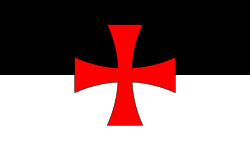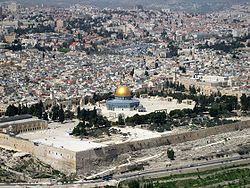Knights Templar
The Poor Fellow-Soldiers of Christ and of the Temple of Solomon (Latin: Pauperes commilitones Christi Templique Salomonici), commonly known as the Knights Templar or the Order of the Temple (French: Ordre du Temple or Templiers), were among the most famous military orders of Western Christianity.[3] The organization lasted for two centuries in the Middle Ages. It was founded after the First Crusade of 1096, with its original purpose to ensure the safety of the many Christians who made the pilgrimage to Jerusalem after it was taken from the Muslims.
| Knights Templar Poor Fellow-Soldiers of Christ and of the Temple of Solomon Pauperes commilitones Christi Templique Salomonici | |
|---|---|
| Active | c. 1119–1314 |
| Allegiance | Papacy |
| Type | Western Christian military order |
| Size | 15,000–20,000 members at peak, 10% of whom were knights[1][2] |
| Headquarters | Temple Mount, Jerusalem |
| Nickname(s) | Order of the Temple |
| Patron | St. Bernard of Clairvaux |
| White mantle with a red cross | |
| Engagements | The Crusades, including: Battle of Montgisard (1177), Battle of Hattin (1187), Battle of Arsuf (1191), Siege of Acre (1190–1191), Siege of Acre (1291) Reconquista |
| Commanders | |
| First Grand Master | Hugues de Payens |
| Last Grand Master | Jacques de Molay |
It was officially endorsed by the Roman Catholic Church around 1129, and became a favored charity by many Christians and grew fast in membership and power. Templar knights wore white mantles quartered by a red cross and were among the most skilled fighting units of the Crusades.[4] Those members of the Order that did not fight managed a large economic infrastructure throughout Christendom, innovating financial techniques that were an early form of banking,[5][6] and building many fortifications throughout the Mediterranean and the Holy Land.
The Templars' success was tied closely to the Crusades; when the Holy Land was lost, support for the Order faded. Rumors about the Templars' secret initiation ceremony created mistrust, and King Philip IV of France, deeply in debt to the Order, began pressuring Pope Clement V to take action against the Order. In 1307, many of the Order's members in France were arrested, tortured into giving false confessions, and then burned at the stake.[7] In 1312, Pope Clement, under continuing pressure from King Philip, disbanded the Order.
Knights Templar Media
The first headquarters of the Knights Templar, on the Temple Mount in Jerusalem. The Crusaders called it "the Temple of Solomon" and from this location derived their name of Templar.
Battle of Hattin in 1187, the turning point leading to the Third Crusade. From a copy of the Passages d’outremer, c. 1490
Convent of Christ Castle, Tomar, Portugal. Built in 1160 as a stronghold for the Knights Templar and besieged in 1190 by the Almohads, it became the headquarters of the renamed Order of Christ. In 1983, it was named a UNESCO World Heritage Site.
Templars being burned
Templar chapel from the 12th century in Metz, France. Once part of the Templar commandery of Metz, the oldest Templar institution of the Holy Roman Empire.
Representation of a Knight Templar (Ten Duinen Abbey museum, 2010 photograph)
Related pages
Notes
- ↑ Burman, p. 45.
- ↑ Barber, in "Supplying the Crusader States" says, "By Molay's time the Grand Master was presiding over at least 970 houses, including commanderies and castles in both east and west, serviced by a membership which is unlikely to have been less than 7,000, excluding employees and dependants, who must have been seven or eight times that number."
- ↑ Malcolm Barber, The New Knighthood: A History of the Order of the Temple. Cambridge University Press, 1994. ISBN 978-0-521-42041-9.
- ↑ Livia Gershon. (2019). 10 Reasons the Knights Templar Were History's Fiercest Fighters. https://www.history.com/news/knights-templar-facts-crusades-wealth.
- ↑ Martin, p. 47.
- ↑ Nicholson, p. 4
- ↑ Malcolm Barber, The Trial of the Templars. Cambridge University Press, 1978. ISBN 978-0-521-45727-9.
- ↑ Burgtorf 2008.
References
- Barber, Malcolm. The New Knighthood: A History of the Order of the Temple. Cambridge University Press, 1994. ISBN 978-0-521-42041-9.
- Barber, Malcolm. The Trial of the Templars, 1st edition, Cambridge University Press, 1978. ISBN 978-0-521-45727-9
- Barber, Malcolm. The Trial of the Templars, 2nd edition, Cambridge University Press, 2006. ISBN 978-0-521-67236-8
- Barber, Malcolm (1992). "Supplying the Crusader States: The Role of the Templars". In BZ Kedar (ed.). The Horns of Hattin. Jerusalem and London. pp. 314–326.
- Burman, Edward. The Templars: Knights of God. Destiny Books, 1986. ISBN 978-0-89281-221-9.
- Martin, Sean, The Knights Templar: The History & Myths of the Legendary Military Order, 2005. ISBN 978-1-56025-645-8.
- Nicholson, Helen. The Knights Templar: A New History. Sutton, 2001. ISBN 978-0-7509-2517-4
- Gershon, Livia. (2019). 10 Reasons the Knights Templar Were History's Fiercest Fighters. https://www.history.com/news/knights-templar-facts-crusades-wealth
Further reading
- Barber, Malcolm. "Who Were the Knights Templar?". Slate Magazine, 20 April 2006.
- Brighton, Simon (2006-06-15). In Search of the Knights Templar: A Guide to the Sites in Britain. London, England: Orion Publishing Group. ISBN 978-0-297-84433-4. Archived from the original (Hardback) on 2010-03-08. Retrieved 2008-08-03.
- Butler, Alan and Stephen Dafoe, The Warriors and the Bankers: A History of the Knights Templar from 1307 to the present, Templar Books, 1998. ISBN 978-0-9683567-2-2.
- Haag, Michael, The Templars: History and Myth, Profile Books, 2008. ISBN 978-1-84668-148-6.
- Partner, Peter. The Knights Templar and their Myth. Destiny Books; Reissue edition (1990). ISBN 978-0-89281-273-8.
- Ralls, Karen. The Templars and the Grail, Quest Books, 2003. ISBN 978-0-8356-0807-7.
- Smart, George. The Knights Templar: Chronology, Authorhouse, 2005. ISBN 978-1-4184-9889-4.
- Upton-Ward, JM. The Rule of the Templars: The French Text of the Rule of the Order of the Knights Templar. The Boydell Press, 1992. ISBN 978-0-85115-315-5.
Other websites
| Wikimedia Commons has media related to Lua error in Module:Commons_link at line 62: attempt to index field 'wikibase' (a nil value).. |
- BBC Radio 4 'On the Trail of The Templars' Program audio, first broadcast 2007-06-18
- The medicine of Knights Templars
- The History of the Knights Templar, by Charles Addison, 1842








